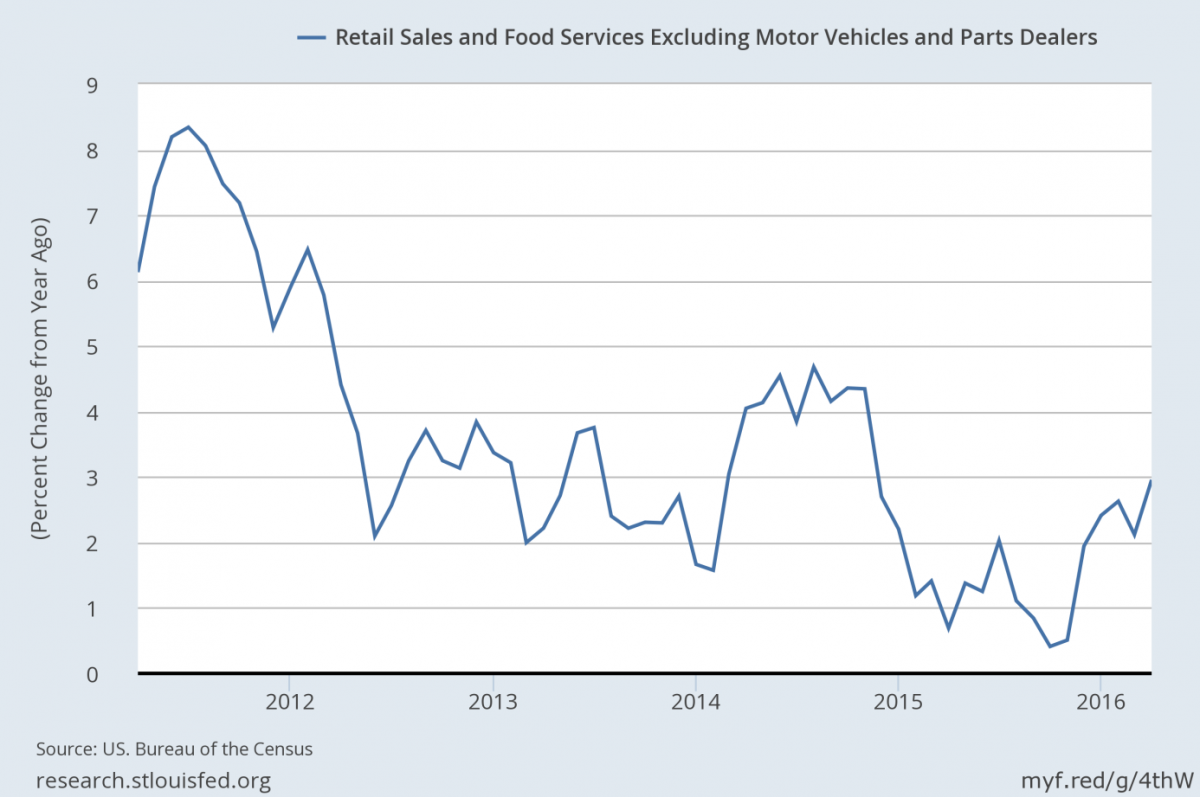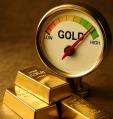April Retail Sales And Gold
 Retail sales jumped 1.3 percent in April. What does this imply for the gold market?
Retail sales jumped 1.3 percent in April. What does this imply for the gold market?
Retail Sales Show Strength in April
Retail sales increased 1.3 percent last month, according to the U.S. Department of Commerce. It was the biggest gain this year, beating expectations by 0.4 percent. Improvements were spread throughout most of the report. However, motor vehicles were the main driver, up an impressive 3.2 percent. Retail sales excluding autos were also strong and increased 0.77 percent. On an annual basis, retail sales and food services increased 3 percent, while retail sales excluding motor vehicles rose 2.96 percent. As one can see in the chart below, the annual pace of growth for retail sales excluding autos has accelerated since October 2015.
Chart 1: Retail and food services sales excluding motor vehicles and parts dealers (percent change from a year ago) from 2011 to April 2016.
Rebound in Retail Sales and Fed Hike
The rise in retail sales in April followed a 0.3-percent decline in March. Therefore, the strong reverse may signal that the U.S. economy is rebounding after a weak first quarter. Indeed, the Atlanta Fed’s GDPNow Model forecast for real GDP growth in the second quarter of 2016 increased from 2.2 percent before the release of the retail sales report to 2.8 percent, which is still less than in 2015 or 2014. However, it is pretty far from recession territory and could restore confidence in the U.S. economy. Such a scenario would be negative for the price of gold. However, the new and alternate “nowcast” of GDP growth used by the New York Fed remained moderate at 1.2 percent in the second quarter of 2016.
The strong retail sales in April should have increased the odds of a June FOMC rate hike; however, it did not. Actually, the opposite happened. The probability of a June hike decreased from 7.5 percent to only 3.8 percent, according to the CME Group FedWatch. Despite the improvement, Mr. Market does not expect a hike until December.
Strong Retail Sales and Gold
Gold prices declined after the April retail sales report was released. However, it managed to close trading at a higher level than the day before. The yellow metal showed strength despite the stronger-than-expected data on retail sales, but also on firmer U.S. dollar index and consumer sentiment (University of Michigan’s index surged 7.6 percent to 95.8 in early May, while economists expected a reading of 89.5). It shows that gold has been quite strong recently. Indeed, gold has rallied in every currency in 2016, which confirms its relative strength. Another aspect of the resilience of gold is the fact that not all recent U.S. economic data was positive. Inventory-to-sales remained at a seven-year high in March. Productivity fell 1 percent in the first quarter of 2016. Wholesale inflation is still largely absent (the PPI rose 0.2 percent in April, but prices have remained flat over the past twelve months). Moreover, disappointing data from China also could support gold as industrial output, retail sales, and fixed-asset investment all slowed down and missed expectations in April.
Conclusions
To sum up, retail sales were strong in April. It is too early to determine whether it was just a short rebound or whether the U.S. economy is really recovering after a weak first quarter of 2016. The stronger-than-expected data on retail sales should have increased the probability of the Fed hike in June and been negative for gold. However, this was not the case. The odds decreased while the price of gold ended Friday higher. The not-so-rosy economic data about the U.S. economy and the disappointing data from China kept investors in a cautious mood. This is positive for the gold market.
Disclaimer: Please note that the aim of the above analysis is to discuss the likely long-term impact of the featured phenomenon on the price of gold and this analysis does not indicate (nor does it aim to do so) whether gold is likely to move higher or lower in the short- or medium-term. In order to determine the latter, many additional factors need to be considered (i.e. sentiment, chart patterns, cycles, indicators, ratios, self-similar patterns and more) and we are taking them into account (and discussing the short- and medium-term outlook) in our trading alerts.



















